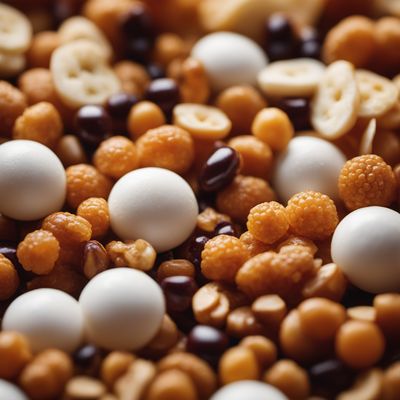
Ingredient
Zinc
The Mighty Mineral: Unleashing the Power of Zinc
Zinc is a bluish-white metal that is commonly used in various industries, but it also holds immense importance in the culinary world and nutrition. It is known for its unique characteristics, including its malleability, resistance to corrosion, and low melting point. In terms of taste, zinc is virtually tasteless, allowing it to seamlessly blend into a wide range of dishes. Its texture is smooth and metallic, adding a subtle richness to foods. In appearance, zinc is often found in the form of supplements or as a component of fortified foods.
Origins and history
Zinc has a rich historical background, with evidence of its use dating back to ancient times. It was first discovered in the Middle East, specifically in Iran and Iraq, around 2,500 years ago. The ancient Egyptians and Romans were known to use zinc for various purposes, including medicinal applications and the production of brass. Over time, zinc became more widely recognized for its importance in human health and nutrition.
Nutritional information
Zinc is a powerhouse of essential nutrients, supporting immune function, DNA synthesis, and cell division. It also aids in wound healing and plays a role in taste perception. A single serving of zinc provides approximately 7 calories and contributes to the recommended daily intake of this vital mineral.
Allergens
Zinc is not known to cause allergies or sensitivities in individuals, making it a safe ingredient for most people.
How to select
When purchasing zinc supplements, it is important to choose reputable brands that adhere to quality standards and have undergone third-party testing for purity and potency. For foods fortified with zinc, look for products that clearly state the amount of zinc added and check the expiration date to ensure freshness.
Storage recommendations
To maintain the freshness and quality of zinc supplements, store them in a cool, dry place away from direct sunlight. For zinc-fortified foods, follow the storage instructions provided on the packaging to ensure optimal shelf life.
How to produce
Zinc is primarily obtained through mining and refining processes. As an amateur, it is not feasible to produce zinc at home due to the complex and hazardous nature of the production process.
Preparation tips
Zinc supplements are typically consumed orally and should be taken as directed by a healthcare professional. When using zinc-fortified foods, incorporate them into recipes as you would with regular ingredients, keeping in mind that excessive heat or prolonged cooking may reduce the zinc content. It is important to note that while zinc is essential for health, excessive intake can have adverse effects, so it is recommended to follow the recommended daily intake guidelines.
Culinary uses
While zinc is not commonly used as a standalone ingredient in culinary applications, it is often added to fortified foods, such as breakfast cereals, energy bars, and nutritional supplements, to enhance their nutritional value.
Availability
Zinc is widely available in supplement form and can be found in most pharmacies, health food stores, and online retailers. Foods fortified with zinc are also readily available in supermarkets and grocery stores.
More ingredients from this category » Browse all

Magnesium
"The Mighty Mineral: Unleashing the Power of Magnesium"

Copper
The Versatile Element: Unleashing the Power of Copper

Potassium
The Essential Electrolyte: Unleashing the Power of Potassium

Chromium
The Mighty Mineral: Unveiling the Power of Chromium

Bromine
The Versatile Element of Bromine

Fluorine
"The Mighty Element: Unleashing the Power of Fluorine"

Selenium
"The Mighty Mineral: Unleashing the Power of Selenium"

Iodine
"The Essential Element: Unveiling the Power of Iodine"

Molybdenum
The Essential Trace Mineral

Calcium
The Mighty Mineral: Unleashing the Power of Calcium

Manganese
The Mighty Mineral: Unveiling the Power of Manganese

Phosphorus
The Essential Mineral